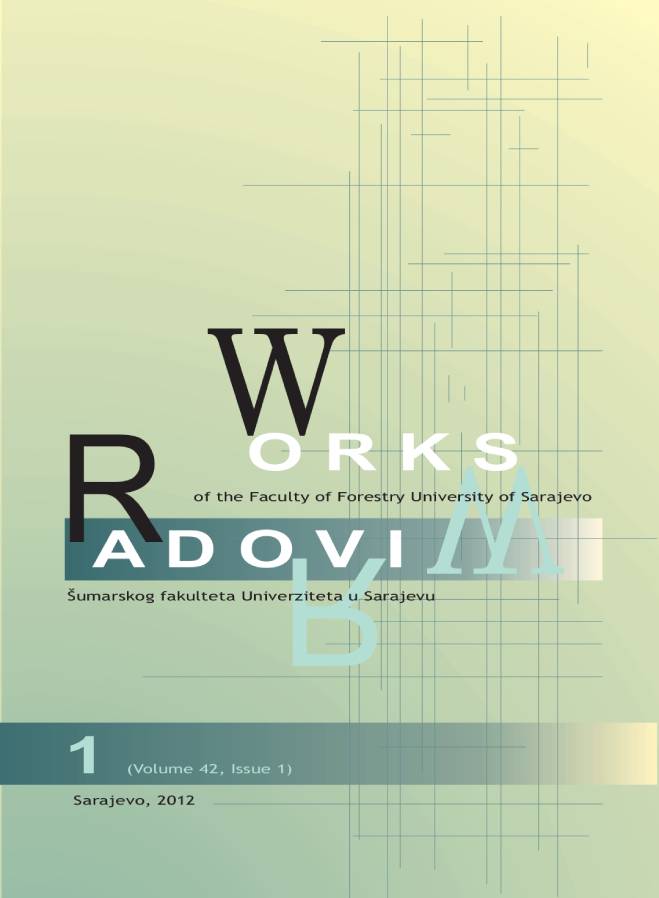DETERMINATION OF VITAMIN C IN SOME BOSNIAN CRATAEGUS L. SPECIES BY SPETROPHOTOMETRIC METHOD
DOI:
https://doi.org/10.54652/rsf.2012.v42.i1.129Keywords:
ascorbic acid, Crataegus, hawthorns, methylene blue, spectrophotometryAbstract
UDK 577.164.2:582.711.714
535.234:577.164.2
Vitamin C or ascorbic acid content has been determined by spectrophotometric method in fruits of some Bosnian hawthorns (Crataegus L). species. Spectrophotometric method used in this study is based on the kinetic reaction between Vitamin C and methylene blue. Measurements were carried out at absorption maximum, λmax= 665 nm. Titrimetric method was used as the reference method for comparison of the obtained results. We found that the lowest content of vitamin C was
106.12 mg/100 g of a dry sample in fruits of the C. monogyna, and the highest level of Vitamin C was found in the C. microphylla (231.96 mg/100 g of a dry sample) fruits. Recoveries of the results obtained by the spectrophotometric method were 101.4% - 108.0% with relative standard deviation (RSD) values ranging between 0.40% - 3.37%.
Obtained results showed that fruits of studied Crataegus L. species are a good source of vitamin C with its potential to be used in food industry as the natural antioxidant.
References
AOAC International, official methods of analysis, 18th ed., AOAC International, Arlington, VA, 2005.
ARAYA, S. P., MAHAJN, M., JAIN, P. (1998): Photometric methods for the determination of vitamin C. Analytical Sciences, 14: 889-894.
BAHORUN, T., TROTIN, F., POMMERY, J., VASSER, J., PINKAS, M. (1994): Antioxidant activities of Crataegus monogyna Extracts. Planta Medica, 60: 323-328.
BAHORUN, T., AUMJAND, E., RAMPHUL, H., RYEHA, M., LUXIMON-RAMMA, A., TROTIN, F. (2003): Phenolic constituents and antioxidant capacities of Crataegus monogyna (Hawthorn) callus extracts. Nahrung, 47 (3): 191-8.
BAŠIĆ, N. (2004): Morfološko-taksonomska istraživanja glogova (Crataegus L.) na području Bosne i Hercegovine. Magistarski rad. Sarajevo.
BECK, G. (1927): Flora Bosne, Hercegovine i oblasti Novoga Pazara. III . Choripetalae (Kaj): 169-172. Beograd-Sarajevo.
BUSHWAY, R. J., KING, J. M., PERKINS, B. M., KRISHNAN, M. (1988) High-performance liquid chromatographic determination of ascorbic acid in fruits, vegetables and juices. Journal of Liquid Chromatography 11: 3415 - 3423.
CHRISTENSEN, K. I. (1992): Revision of Crataegus Sect. Crataegus and Notosect. Crataegineae (Rosaceae-Maloideae) in the old world. Systematic Botany Monographs, 35: 1-199.
CHRISTENSEN, K. I., JANJIĆ, N. (2006): Taxonomic notes on European taxa of Crataegus (Rosaceae). Nordic Journal of Botany, 24: 143-147.
CUI, T., NAKAMURA, K., TIAN, S., KAYAHARA, H., TIAN, Y. L. (2006): Polyphenolic content and physiological activities of Chinese hawthorn extracts. Bioscience Biotechnology and Biochemistry, 70 (12): 2948-56.
DAVEY, M. W., VAN MONTAGU, M., INZÉ, D., SANMARTIN, M., KANELLIS, A., SMIRNOFF, N., BENZIE, I. J. J., STRAIN, J. J., FAVELL, D., FLETCHER, J. (2000): Plant L-ascorbic acid: chemistry, function, metabolism, bioavailability and effects of processing. Journal of the Science of Food and Agriculture, 80, 825-860.
EGEA, I., SANCHEZ-BEL, P., RAMOJARO, F., PRETEL, M. T. (2010): Six edible wild fruits as potential antioxidant additives or nutritional supplements. Plant Foods for Human Nutrition, 65:121-129.
EITENMILLER, R. R., YE L., LANDEN, W. O. (2008): Vitamin analysis for the health and food sciences. CRC Press, Taylor & Francis Group, UK, 231-274.
ENGLARD, S., SEIFTER, S. (1986): The biochemical functions of ascorbic acid. Annual Review of Nutrition, 6: 365-406.
WHO/FAO (2004): Vitamin and mineral requirements in human nutrition. Second edition, World Health Organisation and Food and Agricultural Organisation of the United Nations, Sung-Fung, China, Chapter 7, 130-139.
FUKAREK, P. (1974): Neke vrste drveća i grmlja koje su pogrešno navedene u Flori Bosne i Hercegovine i susjednih krajeva. ANU BiH-Radovi LIV, Odjeljenje prirodno-matematičkih nauka, 15: 45-60.
FOYER, C.H., LELANDIAS, M., EDWARDS, E.A., MULLINEAUX, P. M. (1991): Current topics in plant physiology, 6, ASPP, Rockville, 131.
GUO, C. J. AND YANG, J. J. (2001): Progress in the study of antioxidant capacity of fruits and vegetables. China Public Health, 17: 87-88.
HANACK, T., BRUCKEL, M. H. (1983): The treatment of mild stable forms of angina pectoris using crategutt novo. Therapiewoche, 33: 4331-4333.
JANJIĆ, N. (1998): Neki zanimljivi dendrološki nalazi iz sarajevskog područja. Radovi Šumarskog Fakulteta Univerziteta u Sarajevu, 28(1): 85-103.
JANJIĆ, N. (2002): Nova kombinacija u lepezolisnog ili krivočašičnog gloga, Crataegus rhipidophylla Gand. (Rosaceae). Radovi Šumarskog Fakulteta Univerziteta u Sarajevu, 32(1): 1-7.
LAMPE, J. W. (1999): Health effects of vegetables and fruits: Assessing mechanisms of action in human experimental studies. American Journal of Clinical Nutrition, 70: 475S-490S.
MALÝ, K. (1919): Prilozi za floru Bosne i Hercegovine 5 i 6. Glasnik Zemaljskog Muzeja BiH, Sarajevo, 31: 61-92.
MALÝ, K. (1940): Notizen zur Flora von Bosnien-Herzegovina. Glasnik Zemaljskog Muzeja BiH, Sarajevo, 52: 21-46.
MOWRY, S., ORGEN, P. J. (1999): Kinetics of methylene blue reduction by ascorbic acid, Journal of Chemical Education, 76(7): 970-974.
OGULNESI, M., OKIEI, W., AZEEZ, L., OBAKACHI, V., OSUNSANMI, M., NKENCHOR, G. (2010): Vitamin C contents of tropical vegetables and foods determined by voltammetric and titrimetric methods and their relevance to the medicinal uses of the plants. International Journal of Electrochemical Science, 5: 105-115.
PRYOR, W. A., DAS, B., CHURCH, D. F. (1991): The ozonation of unsaturated fatty acids: aldehydes and hydrogen peroxide as products and possible mediators of ozone toxicity”, Chemical Research in Toxicology, 4: 341-348.
RIGELSKY, J. M., SWEET, B. V. (2002): Hawthorn: pharmacology and therapeutic uses. American Journal of Health and Systematic Pharmacology, 59: 417-422.
ŠAVIKIN, K., ZDINIĆ, G., JANKOVIĆ, T., TASIĆ, S., MENKOVIĆ, N., STEVIĆ, T., ĐORĐEVIĆ, B. (2009): Phenolic content and radical scavenging capacity of berries and related jams from certificated area in Serbia. Plant Foods for Human Nutrition, 64: 212- 217.
ZHANG, Z., CHANG, Q., ZHU, M., HUANG, Y., HO, W. K., CHEN, Z. (2001): Characterization of antioxidants present in hawthorn fruits. The Journal of Nutritional Biochemistry, 12: 144-152.


















